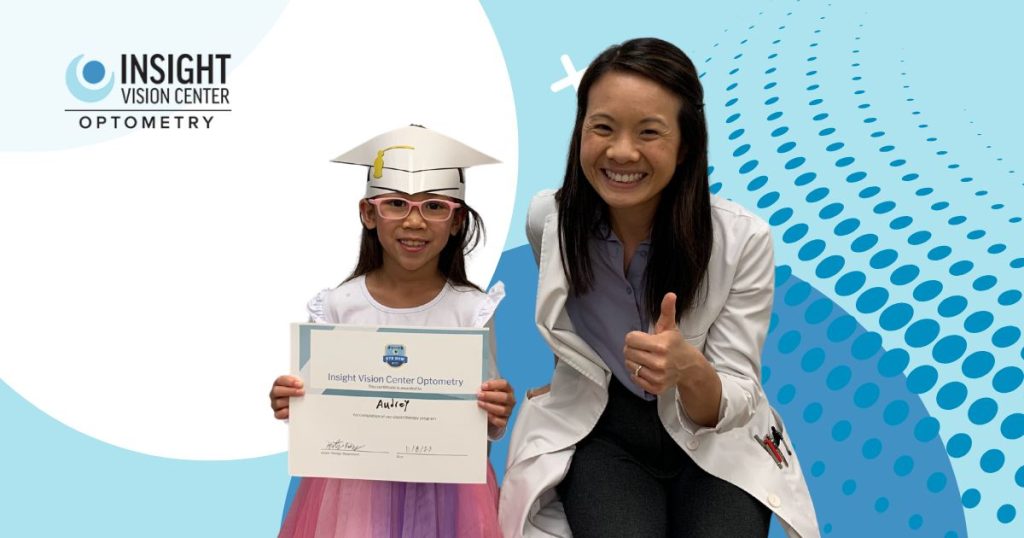
The Highest Rated Specialty Eye Care Center In Orange County

What Our Patients are Saying
“Insight Vision Center staff were excellent and extremely kind as always. The office is super clean and the technology of the machines they use to assist in examining patients in second to none. I am extremely happy to have found Insight Vision Center and their doctors.”
⭐⭐⭐⭐⭐
Michael G
“10/10 experience. Everybody was friendly, and incredibly knowledgeable. I’m so happy I have a go-to optometrist now.“
⭐⭐⭐⭐⭐
Jonathan G.
From the moment your child opens their eyes, vision becomes the primary sense of interaction and learning with the world. Healthy visual development during these first years are critical for their overall development.
Developmental Milestones in Vision Birth to 4 months:
Vision from birth to 5 months
At birth, infants naturally exhibit nearsightedness, with the ability to focus primarily on objects that are approximately 8 to 12 inches away. This range is ideal for seeing the faces of the caregivers holding them. In the first months, babies begin to develop the ability to track moving objects visually, with most children starting this by around three months. During the early weeks, it is common to observe wandering eyes, but if this misalignment persists beyond four months, a professional evaluation becomes necessary.
Vision from 5 to 8 months:
Between the ages of five and eight months, infants experience significant improvements in eye coordination and spatial awareness. Depth perception begins to take shape around five months, allowing babies to understand distance better. During this time, a baby’s color vision typically becomes fully developed, supporting their ability to see a broader spectrum of colors.
Vision from 9 to 12 months:
As infants approach their first year, they gain better judgment of distances and coordination in throwing objects. By nine months, many babies will start pulling themselves up to stand, which enhances their visual skills as they explore their environment from different heights. Around this time, fine motor skills also begin to emerge, promoting further engagement with their surroundings.
Vision from 1 to 2 years:
By the time children reach one to two years of age, their eye-hand coordination is well developed. They engage actively with their environment, showing keen interest in exploration and play. This phase is crucial for visual development as children recognize familiar objects and pictures, and start developing important skills like scribbling, which prepares them for future activities like drawing and writing.
Recognizing Early Signs of Vision Concerns in Infants and Young Children
Excessive Tearing: When Tears Tell a Story
Excessive tearing in infants often points to blocked tear ducts—a common condition where the ducts responsible for draining tears fail to open fully. About 20% of newborns experience this issue, which generally resolves naturally within the first year. However, if tearing persists or is accompanied by swelling, redness, or discharge, consulting our eye doctor is recommended to rule out underlying problems.
Red or Encrusted Eyelids: Indicators of Infection
Red or crusted eyelids can signal an eye infection, such as conjunctivitis. Symptoms often include redness, swelling, and sticky discharge. Infants are particularly susceptible due to their developing immune systems. Prompt evaluation by our eye doctor ensures appropriate treatment and prevents complications that could impact visual development.
Constant Eye Turning (Strabismus): Beyond Normal Development
Strabismus, or constant eye turning, is common in infants under four months as their eye muscles develop. However, if one or both eyes continue to turn inward or outward past this age, it warrants further evaluation. Strabismus affects depth perception and can lead to conditions like amblyopia if left untreated. Approximately 2–4% of children experience strabismus, making early detection essential.
Extreme Sensitivity to Light: A Sign of Photophobia
Photophobia, or extreme sensitivity to light, in infants may indicate elevated pressure in the eye or other ocular issues. If a baby consistently reacts negatively to light exposure or squints excessively, parents should consult our eye doctor. Early diagnosis can rule out serious conditions like congenital glaucoma.
Inability to Focus or Track Objects: Developmental Delays in Vision
By the age of four months, infants should be able to focus on objects and follow them as they move. An inability to do so may indicate visual developmental delays, potentially affecting overall growth and learning. Early intervention can address underlying issues, fostering healthy vision development.
Drooping Eyelids (Ptosis): Obstructing Vision and Beyond
Drooping eyelids, or ptosis, may stem from muscle weakness or nerve-related issues. While some cases are benign, others can obstruct vision or signal underlying neurological conditions. Our pediatric eye doctors can assess the severity and recommend appropriate treatments, which might include surgical intervention.
Discolored Whites of the Eyes: When Color Matters
The sclera (whites of the eyes) can provide vital clues about an infant’s health. Yellowing may suggest jaundice, a common condition in newborns, while redness could indicate an infection. Persistent discoloration requires medical evaluation to address potential liver issues, infections, or other underlying concerns.


Why Early Diagnosis Matters:
Orange County’s Top Rated Pediatric Eye Doctors
The first year of life is a critical period for visual development. Identifying and addressing any of these concerns early can help ensure your child achieves healthy vision, enabling them to explore and interact with the world confidently. Pediatric eye exams are a proactive way to monitor these signs and address issues promptly, laying a strong foundation for your child’s overall development. Visit our top rated pediatric specialty practice in Costa Mesa, for world class eye care for families from across Orange County.
Impact of Vision Problems on Life
Delayed motor skills: Issues with crawling, walking, or other developmental milestones
Vision plays a critical role in an infant’s ability to reach key developmental milestones. Research shows that children with undetected vision problems may experience delays in gross motor skills, which include critical activities like crawling and walking.
Babies rely on their vision to track objects and navigate their environment. Poor vision can hinder their ability to crawl or walk because they struggle to coordinate their movements with what they see. For instance, a child with weak visual tracking may not be able to effectively follow an object, leading to hesitancy in crawling or standing. According to studies, significant delays in reaching these milestones can endanger future physical development and motor coordination. Learning difficulties: Trouble with reading and visual learning
A strong visual foundation is vital for effective learning. Infants and young children are often developing essential visual skills that directly impact their academic success.
Approximately 80% of overall learning is visual, and children with unresolved vision issues may struggle with reading and comprehension. For example, difficulties in color recognition, shape identification, or depth perception can make learning tasks challenging. Research indicates that about 10-15% of preschool children have unaddressed vision problems affecting their learning trajectory.
Social challenges: Difficulty interacting with peers due to visual deficits
Vision problems can create barriers to social interaction among young children, which is critical for emotional and social development.
Children with visual deficits may find it hard to engage in play, read social cues, or navigate peer relationships. This can lead to feelings of isolation or frustration, impacting self-esteem and willingness to engage with peers. Studies reveal that children with vision impairments are more likely to face social challenges and may exhibit related behavior issues, further obstructing their development. Diagnosis of Vision Problems Comprehensive eye examinations starting at 6-12 months of age
A thorough eye examination is crucial for infants as they begin their visual development. The first comprehensive exam is typically recommended between 6 and 12 months. Even if no problems are apparent, this early evaluation is essential in identifying issues that could affect future vision.
Frequently Asked Questions (FAQs)

At what age should my child’s first eye exam be scheduled?
At approximately six months of age, you should schedule your baby’s first comprehensive eye examination. This initial assessment is critical, as it allows the eye doctor to check for nearsightedness, farsightedness, astigmatism, overall eye health, and eye movement abilities. Early detection is essential because although eye health issues are infrequent in infants, identifying problems in their early stages can significantly improve outcomes.

What activities can I do to support my child’s vision development?
Supporting your child’s vision development is both fun and essential. Here are activities tailored for different age ranges:
Birth to 4 Months:
- Use soft lighting like nightlights to create a gentle environment.
- Change the position of your baby’s crib and toys to provide fresh visual stimuli.
- Hold toys within 8-12 inches of your baby’s face to encourage focus.
- Talk and sing to your baby while moving around the room to engage their visual attention.
5 to 8 Months:
- Hang colorful mobiles or interactive toys above their crib for visual tracking.
- Encourage lots of tummy time for improved visual coordination.
- Provide objects of varying textures for them to explore.
- Play interactive games like “patty cake” to increase hand-eye coordination.
9 to 12 Months:
- Engage in hide and seek games to build visual memory.
- Name objects as you point them out to develop vocabulary and visual association.
- Promote crawling, which enhances depth perception and eye coordination.
1 to 2 Years:
- Use balls to play rolling games that strengthen tracking skills.
- Introduce building blocks to enhance their fine motor skills and coordination.
- Read together to stimulate their imagination and visualization skills.

Nurture Your Child’s Vision Development in Orange County – Book an Appointment Today!
Your infant’s vision is a cornerstone of their growth and development, and early care is essential. At Insight Vision Center Optometry, conveniently located in Costa Mesa, we provide specialized eye exams for infants and young toddlers. Our compassionate team detects and addresses vision issues early, ensuring your child gets the best start in life. Serving families across Orange County, we are your trusted partner in pediatric eye care.
Call us at (714) 942-1361 to book your child’s appointment, or schedule online.





